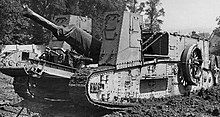Self-propelled gun

A self-propelled carriage is a carriage that can be moved autonomously with an integrated motor on a wheel or chain chassis . Usually at least the engine and driver areas are armored. Weapon systems on self-propelled guns are therefore independent of towing vehicles such as trucks and tractors or draft animals such as horses and mules, compared to conventionally mounted weapons .
Self-propelled guns with a tracked chassis, which have good fragmentation protection or even armor and an artillery weapon stored in a tower, are known in the West as self-propelled howitzers and belong to the tank artillery. In the Warsaw Treaty states they were called self-propelled guns. Chain-powered self-propelled guns often use the hull and drive of battle tanks. Instead of the turret, the almost fixed cannon and less armor are mounted, the cannon usually has a larger caliber than the base tank.
As with the FH155-1, field artillery used to requirea towing vehicle for land marches, even if it was equipped with an auxiliary engine for independent position change. The mountain artillery , whichbelongs to the field artillery , like the mountain howitzer model 56, could be loaded onto pack animals in single loads. Today, field artillery is often equipped with protected guns on self-propelled guns as wheeled racks like the ARCHER artillery system or unprotected ones like the French CAESAR . These are more cost-effective, can be transported by air due to their lower weight, do not burden the transport infrastructure in the operational area with damage caused by vehicles such as armored chassis and therefore do not require armored transporters such as the German ELT for the further land march.
history
This type of weapon was developed as early as the First World War (mainly by the French army) and was used on a larger scale in the Second World War . The Red Army used the SU-100U self-propelled gun in the winter war of 1939/1940. Later on, SU-152 and ISU-152 found widespread use and were used until the 1970s. There were both carriages with permanently mounted guns and those in which the weapon was set down on the ground, such as the German grasshopper of the Wehrmacht or, like the Bundeswehr, the gl (4 × 4) Faun GT 8/15 device carrier with the light one Field howitzer 105 mm.
Since the end of the Second World War, tank destroyers have increasingly been used for mobile anti- tank defense. The immediate fire support of the infantry, which was mechanized starting from the Second World War, went from assault guns , which mostly only fought enemy forces with direct fire , then to self-propelled howitzers , which achieved the same effect in indirect fire at greater distances, but were out of range enemy tanks and infantry.
In the Bundeswehr , the US M107 and M110 were still used in the division and corps artillery in the first few decades . The M7 Priest served as initial equipment with self-propelled howitzers . The M109 self-propelled howitzer followed in the 1960s. It was replaced by the Panzerhaubitze 2000 .
Examples of missiles made manoeuvrable on self-propelled guns were the SS-20 or the MGM-31 Pershing during the Cold War .
Individual evidence
- ↑ Waffentechnisches Taschenbuch, Rheinmetall, 5th edition, 1980, page 366
- ↑ Should deterrence work ... in ZEIT No. 33, August 7, 1981

